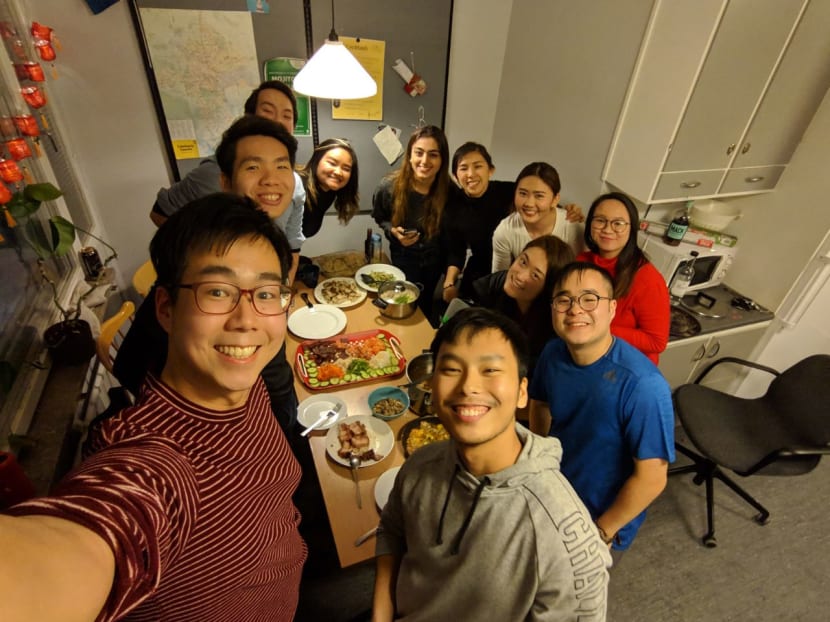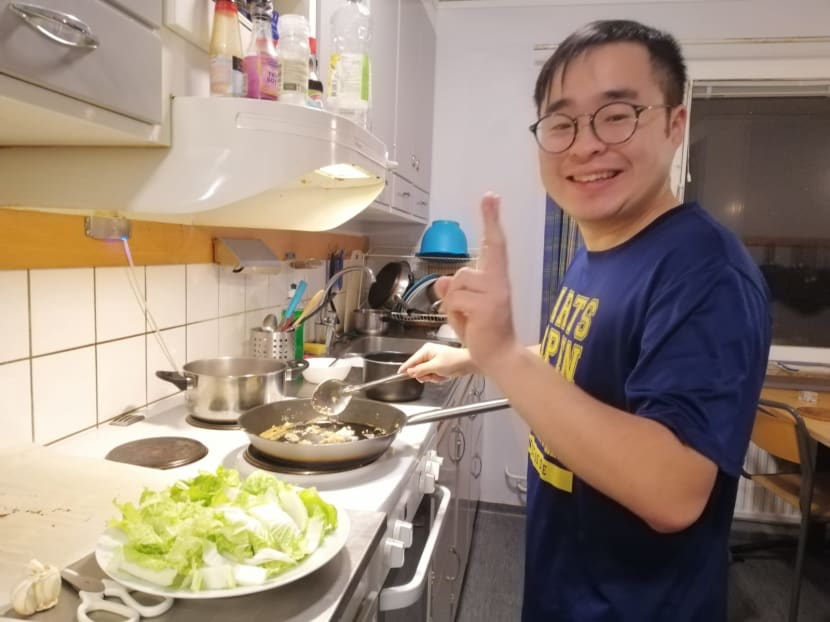Gen Y Speaks: DIY-meals in pricey Sweden made me appreciate Singapore hawkers all the more
Lunch boxes were ubiquitous in my primary school life. So imagine the nostalgia when I arrived in Sweden early this year for a semester-long exchange at Uppsala University and saw students bringing their own Tupperware to school.

The author (in blue) celebrating Chinese New Year with other Singaporeans at Uppsala University over a meal.
Lunch boxes were ubiquitous in my primary school life. My mother would pack a bento containing fried rice, meat and vegetables for me to take to school, and I always looked forward to finishing them up during recess.
But moving on to secondary school, I stopped bringing lunch boxes because I did not want to be teased by my schoolmates as a “mummy’s boy”. So I settled for canteen meals.
So imagine the nostalgia when I arrived in Sweden early this year for a semester-long exchange at Uppsala University and saw students bringing their own Tupperware to school.
I was soon surprised by how serious the Swedes are about packing their own home-cooked food to take to school when I saw more than 20 microwave ovens and refrigerators at pantries across the campus.
Very soon, I found myself following suit, and not by choice really. There is a high price to pay — literally — if I choose to eat out.
A typical meal here starts from 100 Swedish kronor, which is about S$14.60. Even at the cheaper IKEA or Burger King, it will cost me close to S$10 per meal.
Unlike major cities such as London or New York, Uppsala is a small city and I do not have the luxury of having many food choices.
Staples here include pasta, pizza and burgers. There is a sprinkling of Asian restaurants, but with their exorbitant prices, I cannot rely on them for my daily meals. It is hard to accept an ordinary stir-fry dish that costs close to S$30.
Food at the on-campus canteen isn’t any cheaper. A hot dish with a bread costs 75 kronor (S$11), while a salad costs 35 kronor ($5).
For someone used to S$5 meals at hawker centres, these are clearly too rich for my blood.
I initially thought the Swedes, as locals, would be okay with how much their food costs. But according to my Swedish friend Philip Higwall, a 20-year-old first-year undergraduate, even locals like him find dining out to be expensive. So they prepare their own meals to take to school or work.
I too adopted this habit shortly after arriving in Uppsala.
COOKING COMFORT FOOD
Lunch for me need not be sophisticated. With a pressure cooker and other tools such as a sushi roller mat brought from Singapore, lunch could be a simple sushi roll or a one-pot mixed vegetable rice. It is definitely more economical than eating out.
In fact, because of how costly things are in Sweden, I have learnt to be more financially prudent. For instance, I will make an effort to find out which supermarket has cheaper groceries and recycle drink cans in exchange for discount coupons.
How ironic that I have adopted these money-saving #lifehacks we millennials often ridicule for being old-fashioned habits of aunties and uncles.
In truth, there is no shame in trying to save a few pennies, as even preparing one’s own meals here is not cheap. Items like tofu and spring onions, which cost less than a dollar back home, are twice or thrice more costly here.

The author cooking in the kitchen at his dormitory. Photo courtesy of Sean Lim Wei Xin
As someone who lives to eat, I am glad I have come prepared to learn how to whip up comfort food by packing pre-mixes of local delicacies like chicken rice to condiments like sambal belacan.
I am fortunate to be with Singaporeans who cook decently. Together with them, we tried replicating local favourites like bak chor mee and curry chicken.
Some turned out quite horrible — like the overly-vinegary lor mee I made which lacked the starchy texture. But other half-decent attempts helped satisfy our craving for Singapore food.
It is also a blessing to cook together frequently with my fellow countrymen. I have seen how others, without the company of friends, had to cook for themselves.
Preparing a meal for one person is more challenging because of limitations to what one can cook. For example, it is impractical and hard to make bak kut teh for one person.
Supermarket ingredients tend to be sold in fixed and huge portions, so eating alone means having the same pork or cabbage for consecutive meals if one wants to finish them before they turn bad.
There were times when I ran out of ideas or found cooking too much of a hassle. But it is overall fulfilling, especially when every one enjoys the food and bond over our makan sessions.
For one thing, my Swede friend Philip enjoyed the mala hotpot we made, which was surprising since I have always thought they could not tolerate spiciness.
In contrast, Louna Aut, a 21-year-old exchange student from France, found my peppery bak kut teh too spicy for her liking.
LESSONS LEARNT
While I still find meal preparation satisfying, I do miss the convenience, variety and affordability of food back home. There is no need to fuss over grocery runs or pore over recipes. All I had to do is to drop by the hawker centre and a meal is settled.
Spending close to five months overseas has made me realise I, along with many Singaporeans, have been taking our hawkers for granted.
For years, they have been under-appreciated. We can only blame ourselves if nobody wants to be a hawker in the future.
The social position of hawkers should be elevated such that society sees it as a respectable and niche craft. It will be gastronomically tragic if our well-loved favourites disappear from the food scene.
Ditto if meals become so unaffordable that we lose the convenience of eating out and are forced to take lunch boxes to work — out of necessity like in Sweden.
ABOUT THE AUTHOR:
Sean Lim Wei Xin is a third-year political science student from National University of Singapore on exchange at Uppsala University from January to June 2019.






